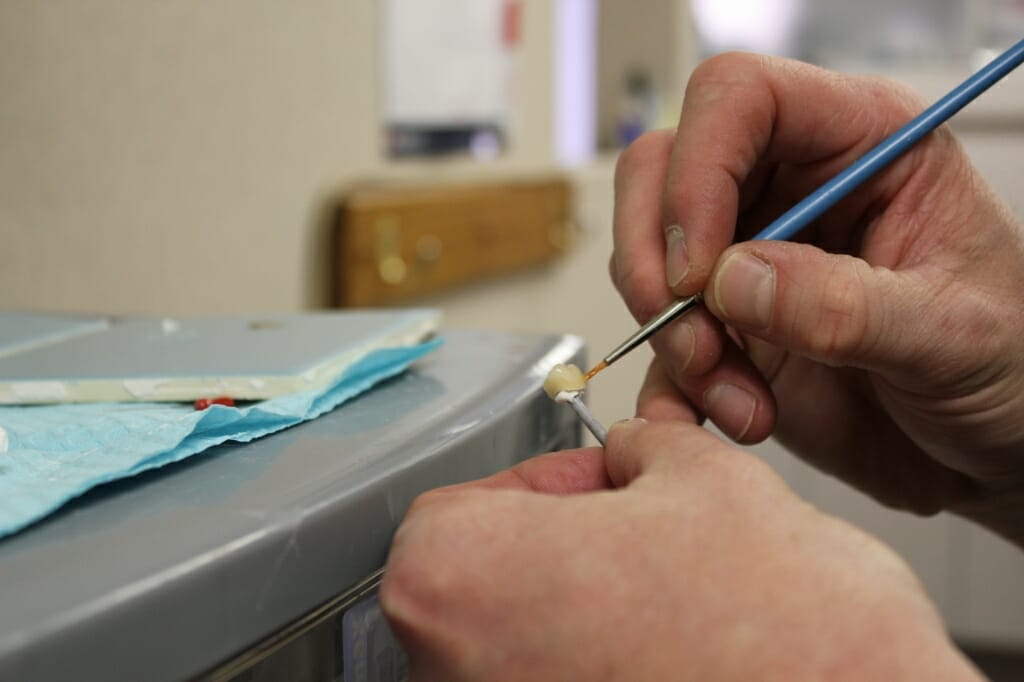Restorative Dentistry
At Schneider Family Dental we want to see your teeth at their best. To do this we offer a number of procedures that will enhance not only the health but the look of your smile.

Fillings
One of the most common dental restorations is dental fillings. When a cavity is minor, a filling can maintain the strength of the tooth and prevent the decay from growing. The process involves using a tooth-colored composite resin filling to seal any cracks or holes in the tooth.
Dr. Matt will begin this procedure by delicately removing decay from your damaged tooth. Then he’ll fill in cleaned area with the composite resin. For both cosmetic and health reasons, our office uses composite fillings over traditional metal amalgam fillings.
The composite resin fillings create a strong physical bond with the prepared tooth. They not only look natural but respond naturally too, allowing bite stress to pass through the tooth while receiving biting force.
Dental Crowns
A crown is a cap that is placed on and surrounds a damaged tooth. When a tooth is decayed or cracked, the decay is removed and a filling is placed directly inside the tooth. However, when the tooth is broken, too worn, or partially destroyed by tooth decay a crown is used to restore its function and health.
Dental crowns are necessary when a tooth is too weak to support a filling, or if a tooth is missing altogether. In some cases, a crown can be placed on an already existing tooth. In others, a dental implant may be needed for the crown to attach to. After an examination, Dr. Matt will be able to recommend the best option and carefully walk you through the process.
Dental Bridges
Rather than capping a single tooth, a bridge is often used to replace missing teeth and maintain the shape of your face. They also help ease the stress on your bite. Gaps left by missing teeth will eventually cause the remaining teeth to shift into the empty spaces.
Missing teeth can negatively impact the health of your overall mouth by altering your bite. A misaligned bite can cause further damage with each chew. The imbalance caused by these gaps can also lead to gum disease and joint disorders. A dental bridge literally bridges the gap where one or more teeth may have been and resolves this problem.
To find out what else our Dublin team can do to restore your smile, schedule an appointment today by calling (614)889-2211!
Restorative Dentistry: Frequently Asked Questions
At Schneider Family Dental, we understand that a healthy smile is about more than just appearance. It’s about comfort, confidence, and long-term function. Whether you’re dealing with decay, damage, or missing teeth, our restorative services are designed to help you eat, speak, and smile with ease. Here are a few common questions we hear from patients considering restorative treatment.
Can restorative dentistry improve my smile?
Absolutely. Restorative dentistry is designed to repair damage and restore function, but many treatments also enhance the look of your smile. Crowns, fillings, bridges, and implants can be color-matched to your natural teeth for seamless results.
Will I need anesthesia during restorative treatment?
Most restorative procedures involve local anesthesia to keep you comfortable. However, it may be possible to have some treatment done without feeling numb. Talk to Dr. Schneider about your options!
Are fillings considered a restorative dental treatment?
Yes, fillings are one of the most common forms of restorative care. They restore the structure of a tooth after decay is removed, helping to preserve your natural tooth and prevent further damage.
Is a crown or filling better?
It depends on the extent of the damage. Fillings are ideal for small to moderate cavities, while dental crowns are typically used when more tooth structure is compromised. We’ll recommend the option that offers the best long-term protection for your tooth.
How many times can a filling be replaced?
Fillings typically last several years, but they aren’t permanent. How often they need to be replaced depends on the material, your oral hygiene, and wear from chewing or grinding. If a filling becomes worn, cracked, or loose, it may need to be replaced—or in some cases, upgraded to a crown.
What materials are most commonly used in restorative dentistry?
Tooth-colored composite resin is often used for fillings because it blends in naturally. For crowns and bridges, we may use ceramic, porcelain, or zirconia—materials known for their durability and lifelike appearance. Our office always uses materials that are both strong and aesthetic.
What is considered major restorative treatment?
Major restorative procedures involve more complex repairs or replacement of missing teeth. This can include crowns, bridges, dental implants, root canals, and full or partial dentures. These treatments are designed to restore full function and structure to your bite.
Whether you need a minor repair or a full restoration, our team is here to walk you through your options with care and clarity. If you have more questions about restorative dentistry or want to schedule a consultation, give us a call—we’re happy to help you rebuild your smile with confidence.




